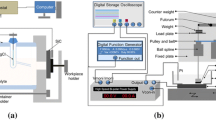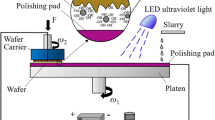Abstract
Single-crystal 4H–SiC is a promising next-generation semiconductor material for high-power and low-loss power devices. Electrochemical mechanical polishing (ECMP) is a very promising polishing technique for the manufacture of SiC wafers owing to its high efficiency and low cost. In this study, the effects of the balance between the anodic oxidation rate and the polishing rate of the oxide layer on the polishing performance of slurryless ECMP were studied in an attempt to obtain an atomically smooth surface efficiently. The polishing performance of ECMP was evaluated from the viewpoints of surface roughness, residual oxide, and material removal rate. It was found that the balance between the anodic oxidation rate and the polishing rate of the oxide layer strongly affects the surface roughness; the polishing rate of the oxide layer should be greater than the anodic oxidation rate to obtain an atomically smooth surface. By controlling this balance at a current density of 10 mA/cm2, we were able to decrease the surface roughness of a diamond-lapped 4H–SiC (0001) surface from Sq 4.290 to 0.577 nm and obtained a high material removal rate of about 10 μm/h. This study provides a promising way of obtaining atomically flat surfaces by slurryless ECMP.









Similar content being viewed by others
References
Stalter O, Kranzer D, Rogalla S, Burger B (2010) Advanced solar power electronics. In: 2010 22nd International symposium on power semiconductor devices and IC’s (ISPSD). IEEE, pp 3–10
Zhang H, Tolbert LM, Ozpineci B (2011) Impact of SiC devices on hybrid electric and plug-in hybrid electric vehicles. IEEE Trans Ind Appl 47(2):912–921
Wrzecionko B, Bortis D, Kolar JW (2014) A 120 °C ambient temperature forced air-cooled normally-off SiC JFET automotive inverter system. IEEE Trans Power Electr 29(5):2345–2358
Friedli T, Round SD, Hassler D, Kolar JW (2009) Design and performance of a 200-kHz all-SiC JFET current DC-link back to back converter. IEEE Trans Ind Appl 45(5):1868–1878
Peftitsis D, Tolstoy G, Antonopoulos A, Rabkowski J, Lim JK, Bakowski M, Ängquist L, Nee HP (2012) High-power modular multilevel converters with SiC JFETs. IEEE Trans Power Electr 27(1):28–36
Zhai W, Gao B, Chang J, Wang H (2019) Optimization of ultrasonic-assisted polishing SiC through CFD simulation. Nanomanuf Metrol 2(1):36–44
Yamamura K, Takiguchi T, Ueda M, Deng H, Hattori AN, Zettsu N (2011) Plasma assisted polishing of single crystal SiC for obtaining atomically flat strain-free surface. CIRP Ann 60(1):571–574
Van Bui P, Sano Y, Morikawa Y, Yamauchi K (2018) Characteristics and mechanism of catalyst-referred etching method: application to 4H–SiC. Int J Autom Technol 12(2):154–159
Hara H, Sano Y, Mimura H, Arima K, Kubota A, Yagi K, Murata J, Yamauchi K (2007) Damage-free planarization of 4H–SiC (0001) by catalyst-referred etching. Mater Sci Forum 556–557:749–751
Kikuchi M, Takahashi Y, Suga T, Suzuki S, Bando Y (1992) Mechanochemical polishing of silicon carbide single crystal with chromium (III) oxide abrasive. J Am Ceram Soc 75(1):189–194
Kubota A, Kurihara K, Touge M (2012) Fabrication of smooth surface on 4H–SiC substrate by ultraviolet assisted local polishing in hydrogen peroxide solution. Key Eng Mater 523–524:24–28
Lai CL, Lin SH (2003) Electrocoagulation of chemical mechanical polishing (CMP) wastewater from semiconductor fabrication. Chem Eng J 95(1–3):205–211
Murata J, Yodogawa K, Ban K (2017) Polishing-pad-free electrochemical mechanical polishing of single-crystalline SiC surfaces using polyurethane–CeO2 core–shell particles. Int J Mach Tools Manuf 114:1–7
Li C, Bhat IB, Wang R, Seiler J (2004) Electro-chemical mechanical polishing of silicon carbide. J Electron Mater 33(5):481–486
Deng H, Hosoya K, Imanishi Y, Endo K, Yamamura K (2015) Electro-chemical mechanical polishing of single-crystal SiC using CeO2 slurry. Electrochem Commun 52:5–8
Lee HS, Jeong HD (2009) Chemical and mechanical balance in polishing of electronic materials for defect-free surfaces. CIRP Ann 58(1):485–490
Deng H, Yamamura K (2013) Atomic-scale flattening mechanism of 4H–SiC (0001) in plasma assisted polishing. CIRP Ann 62(1):575–578
Yang X, Sun R, Kawai K, Arima K, Yamamura K (2018) Surface modification and microstructuring of 4H–SiC (0001) by anodic oxidation with sodium chloride aqueous solution. ACS Appl Mater Interfaces 11(2):2535–2542
Yang X, Yang X, Kawai K, Arima K, Yamamura K (2019) Ultrasonic-assisted anodic oxidation of 4H–SiC (0001) surface. Electrochem Commun 100:1–5
Yang X, Sun R, Ohkubo Y, Kawai K, Arima K, Endo K, Yamamura K (2018) Investigation of anodic oxidation mechanism of 4H–SiC (0001) for electrochemical mechanical polishing. Electrochim Acta 271:666–676
Acknowledgements
This work was partially supported by a Grant-in-Aid for Challenging Research (Exploratory) (18K18810) from the MEXT, Japan, a research grant from the Mitsutoyo Association for Science, and a research grant from the Technology and Machine Tool Engineering Foundation.
Author information
Authors and Affiliations
Corresponding author
Rights and permissions
About this article
Cite this article
Yang, X., Yang, X., Sun, R. et al. Obtaining Atomically Smooth 4H–SiC (0001) Surface by Controlling Balance Between Anodizing and Polishing in Electrochemical Mechanical Polishing. Nanomanuf Metrol 2, 140–147 (2019). https://doi.org/10.1007/s41871-019-00043-5
Received:
Revised:
Accepted:
Published:
Issue Date:
DOI: https://doi.org/10.1007/s41871-019-00043-5




